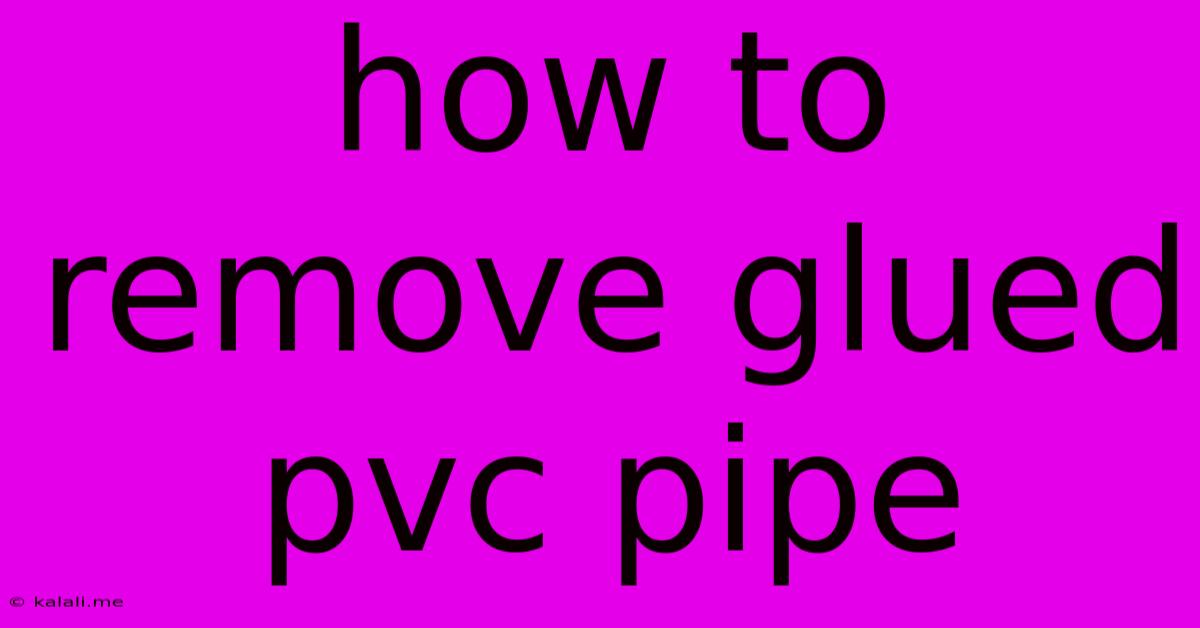How To Remove Glued Pvc Pipe
Kalali
Jun 05, 2025 · 3 min read

Table of Contents
How to Remove Glued PVC Pipe: A Comprehensive Guide
Removing glued PVC pipe can be a challenging task, but with the right tools and techniques, it's achievable. This comprehensive guide provides a step-by-step approach to safely and effectively remove glued PVC pipes, minimizing damage and ensuring a clean finish. This process requires patience and precision, so let's get started.
Understanding the Challenge: PVC pipes are joined using a solvent cement that creates a strong, permanent bond. This makes separating them without damaging the pipe a significant hurdle. However, understanding the limitations of the glue and applying the correct force and techniques can yield successful results.
Tools You'll Need:
- Utility knife or PVC pipe cutter: For scoring the pipe joint.
- Hammer: For carefully applying controlled force.
- Pipe wrench: For gripping and twisting the pipe. Choose a size appropriate for your pipe diameter.
- Heat gun (optional): Can help soften the glue, making separation easier (use with caution).
- Safety glasses: Essential for protecting your eyes from flying debris.
- Gloves: To protect your hands.
- Reciprocating saw (for stubborn cases): Use as a last resort.
Step-by-Step Removal Process:
-
Assess the Situation: Before starting, carefully examine the glued joint. Note the pipe diameter, the type of fitting, and the overall condition of the pipes. This assessment will help you choose the best approach.
-
Scoring the Joint: Using a utility knife or PVC cutter, carefully score the glued joint all the way around the pipe. This creates a weakened point and helps break the bond. Don't cut too deeply; you only need to score the surface of the glue.
-
Applying Heat (Optional): If you have a heat gun, gently apply heat to the scored joint. The heat can soften the glue, making it easier to break the bond. Caution: Be extremely careful not to overheat the PVC, as this can cause it to warp or melt.
-
Controlled Force and Twisting: Use a pipe wrench to grip one section of the pipe firmly. Apply steady, controlled force, twisting gently back and forth. Avoid using excessive force, as this can damage the pipe. Work gradually, giving the glue a chance to break.
-
Hammering (Use With Caution): If twisting doesn't work, carefully tap the pipe near the joint with a hammer. Use light, controlled taps, aiming to break the glue bond. Avoid direct hammering on the pipe itself to prevent damage.
-
Reciprocating Saw (Last Resort): If all other methods fail, use a reciprocating saw with a fine-tooth blade to carefully cut through the pipe near the joint. This should be used only as a last resort, as it will result in cutting the pipe.
-
Clean Up: Once the pipe is removed, clean up any remaining glue residue from both pipes using a suitable solvent or cleaner.
Preventing Future Problems:
- Proper Glue Application: Ensure correct application of PVC cement during installation to create a strong, reliable bond that lasts.
- Correct Pipe Sizing: Use the correct pipe and fitting sizes to prevent stress on the joints.
- Careful Installation: Avoid forcing the pipes during installation, which could create weak points.
Removing glued PVC pipes requires patience and careful technique. By following these steps and using the appropriate tools, you can successfully remove the pipes with minimal damage. Remember to prioritize safety by wearing appropriate protective gear throughout the process. Remember to always consult a professional plumber for complex or critical situations.
Latest Posts
Latest Posts
-
What Happens If You Eat Raw Jimmy Dean Sausage
Jun 07, 2025
-
Can You Delay Graduating To Take More Courses College
Jun 07, 2025
-
How To Tell If Propane Tank Empty
Jun 07, 2025
-
Ac Delco Battery Date Code Lookup
Jun 07, 2025
-
How To Re Polish Stainless Steel
Jun 07, 2025
Related Post
Thank you for visiting our website which covers about How To Remove Glued Pvc Pipe . We hope the information provided has been useful to you. Feel free to contact us if you have any questions or need further assistance. See you next time and don't miss to bookmark.